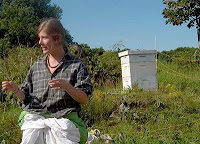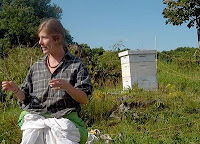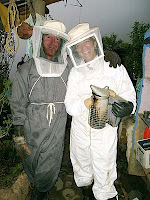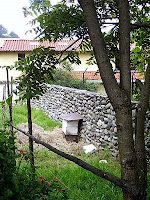Honey Gardens on the Food Network
A feature from the series “My Life in Food” that includes Honey Gardens will be on national TV on Saturday April 11 @ 6:30 pm on the Food Network.

Last summer Meriwether spent time with the bees, in the bee yards, as she taught about bees in Vermont and around her college in Colorado Springs, Colorado, and this was filmed for this TV special on raw honey and another farm that produces raw milk.
“In August, the bees are working on the clover family plants and goldenrod. We are starting to see the first of the aster flowers. The vegetables on the farm that need to be pollinated have already been visited by the bees. At this time, it is important to think about whether the bees will have enough food to get through the winter. It has been a cool, wet summer, and I suspect that the bees have not made as much food here as in previous seasons.”
Raw Honey Fruit Kabobs
by Ann Kennedy
Puree one large banana with 3/4 cup raw honey in a processor or blender.
On wood skewers, alternate chunks of fresh fruit. Good combinations are watermelon, cantaloupe, honeydew, and bananas or pineapple, bananas, and strawberries.
Dip kabobs in honey mixture and roll in wheat germ. Put in freezer or refrigerator until firm. This is also good using only bananas, cut in 1″ thick slices and threaded with a toothpick.
We appreciate your interest in and support of the bees and their work.
 supportive. For all least four decades, we have been listening to the medical community’s advice about the quality and quantity of fat and fiber in our diets, and the increased incidence of heart disease, diabetes (particularly Type II, adult onset), cancer, and obesity among our population. As a result, many people have shifted their dietary intakes toward a plant-based diet which is rich in vitamins, minerals, fiber, and antioxidants, just to name a few nutrients. We have improved our diets “in layers,” meaning that the initial shift for some people is toward a plant-based diet. Subsequent layers or shifts include incorporating more organic produce and free-range poultry and meats, and what we call “superfoods.” Superfoods are called such because they are foods that are naturally rich in vitamins, minerals, and trace minerals. Blue-green algaes (e.g., chlorella and spirulina), seaweeds (e.g., kelp and dulse), bee pollen, and raw honey are examples of superfoods because of their extraordinarily generous contents of beneficial nutrients.
supportive. For all least four decades, we have been listening to the medical community’s advice about the quality and quantity of fat and fiber in our diets, and the increased incidence of heart disease, diabetes (particularly Type II, adult onset), cancer, and obesity among our population. As a result, many people have shifted their dietary intakes toward a plant-based diet which is rich in vitamins, minerals, fiber, and antioxidants, just to name a few nutrients. We have improved our diets “in layers,” meaning that the initial shift for some people is toward a plant-based diet. Subsequent layers or shifts include incorporating more organic produce and free-range poultry and meats, and what we call “superfoods.” Superfoods are called such because they are foods that are naturally rich in vitamins, minerals, and trace minerals. Blue-green algaes (e.g., chlorella and spirulina), seaweeds (e.g., kelp and dulse), bee pollen, and raw honey are examples of superfoods because of their extraordinarily generous contents of beneficial nutrients.


